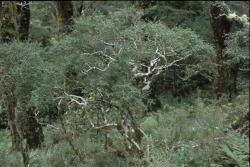- Taxon
- Gallery
Evergreen, spreading, dioecious shrub, up to 4 m tall. Shrubs with 1–5 main trunks, trunks up to 80 mm diam.; outer bark grey, smooth to slightly rough; inner bark, when exposed, pink to grey-pink. Branchlets aggregated toward branch ends, sparse to crowded, virgate, spreading to upright, not divaricating or drooping, slender, branching angle 30–70°, sparsely to moderately lenticellate, leaves moderately to densely covered with simple and branched hairs when young, becoming glabrous with age. Seedling stem sparsely to moderately covered with simple and branched hairs, sparsely lenticellate; primary branchlets ± patent to main stem; leaves 9–20 × 5–12 mm, obovate, apex retuse with a prominent cleft or toothed to sometimes praemorse, margin and lamina with conspicuous orange glands, base attenuate. Leaves 11–22 × 7–11 mm, dark green, usually glossy, obovate or oblong-obovate, subcoriaceous, lamina base often with a narrow dark band, alternate on branchlets or brachyblasts; orange glands inconspicuous on lamina and margin of immature leaves, conspicuous on margin of abaxial surface when mature or dry; apex slightly retuse to sometimes ± entire, cleft up to 1 mm deep; margin entire; base attenuate to shortly attenuate; petiole 1.7–3.0 mm long, plano-convex; simple and sometimes branched hairs on petiole, leaf margin, base of midrib, apex, and proximal end of lamina, becoming glabrous or glabrate with maturity. Flowers axillary or in fascicles. Female fl owers solitary or in fascicles of 2(–3), usually sparse; peduncles 2.0–2.4 mm long; subtended by a bract, 0.6–0.7 × 0.6–0.7 mm, green, triangular, apex subacute, margin fimbriate; sepals 4, usually free but sometimes slightly fused at the base, 0.8–0.9 × 0.7–0.8 mm, green, triangular, abaxial and adaxial surfaces glabrous, apex subacute, margins fi mbriate; petals 4, free, 1.3–1.6 × 1.0–1.1 mm, broadly elliptic, light green or cream and flushed maroon around margin, upright, abaxial and adaxial surfaces glabrous and with a few orange glands, claw indistinct or <0.2 mm long, apex obtuse, margin fimbriate; ovary 1.3–1.4 × 1.0–1.1 mm, usually withconspicuous glands; style distinct, c. 0.2 mm long; stigma 0.6–0.8 × 0.6–0.8 mm, spherical, globular, protruding from closed petals; anthers sessile, rudimentary, 0.6–0.7 × 0.4–0.5 mm, pollen absent. Male flowers solitary or in fascicles of up to 4, usually dense; peduncles 1.4–2.3 × 0.6–0.7 mm; subtended by a bract, 0.6–0.7 × 0.6–0.7 mm, green, triangular, apex subacute, margin fi mbriate; sepals 4(–5), usually free but sometimes slightly fused at the base, 0.9–1.1 × 0.7–0.8 mm, green, triangular, abaxial and adaxial surfaces glabrous, apex obtuse, margins sparsely fimbriate; petals 4(–5), free, 1.9– 2.5 × 1.4–1.6 mm, obovate, green and often flushed maroon around margin, spreading from base and recurved at anthesis, abaxial and adaxial surfaces glabrous and with scattered orange glands, claw 0.2–0.6 mm long, apex subacute to obtuse, margins fimbriate; filaments <0.2 mm long, sometimes sessile, attached to lower half of petal; anthers 1.1–1.4 × 0.6–1.0 mm, cream, apices usually with a small tuft of hairs, sometimes glabrous; gynoecium rudimentary, 0.2–0.3 × 0.2–0.3 mm. Fruit a drupe. Mesocarp green when immature, style base persistent; at maturity 3.4–5.3 × 3.4–5.2 mm, circular or sometimes broadly elliptic, purple or violet. Endocarp 2.6–3.3 × 2.3–2.6 mm, usually circular, terete, light yellow-green to creambrown with paler ± indistinct longitudinal veins. FL Aug–Sep; FT Oct–Aug.
[Reproduced from Heenan & de Lange (2004, New Zealand J. Bot. 42: 753–769) with permission from The Royal Society of New Zealand.]




